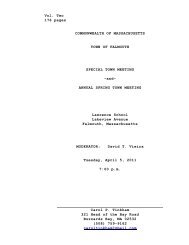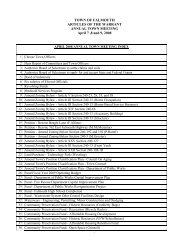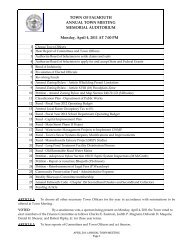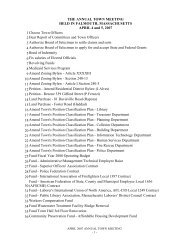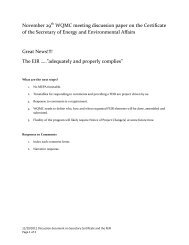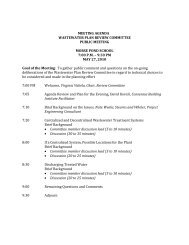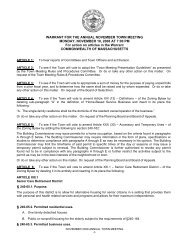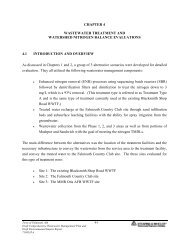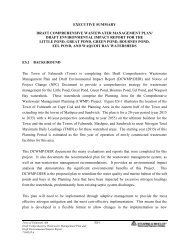EXECUTIVE SUMMARY (Without Figures) rev - Town of Falmouth
EXECUTIVE SUMMARY (Without Figures) rev - Town of Falmouth
EXECUTIVE SUMMARY (Without Figures) rev - Town of Falmouth
You also want an ePaper? Increase the reach of your titles
YUMPU automatically turns print PDFs into web optimized ePapers that Google loves.
As with any treatment system applied to many individual properties, if the technology was<br />
applied at every property in the planning area, there would be significant monitoring and<br />
operational requirements and significant uncertainty <strong>of</strong> its true performance (daily composite<br />
monitoring <strong>of</strong> these systems would be impractical). If the technology did not perform well, or if<br />
additional pollutants needed to be removed in the future (phosphorus, pharmaceuticals, organic<br />
carbon, or more nitrogen), there would be a great expense to modify the systems or replace them<br />
with a conventional sewer. Also, these systems do not perform well at houses with seasonal use<br />
because they rely on a biological process that must be maintained year-round. They would not<br />
perform well if they were “started up” in June as summer residents or renters occupy their houses<br />
for just a few months in the year.<br />
Due to this drawback, proponents <strong>of</strong> this technology propose creating cluster/decentralized<br />
WWTF in the planning area. If these systems were sized at flows <strong>of</strong> 15,000 gallons per day,<br />
approximately 120 WWTF would need to be sited, operated, and maintained to handle the<br />
projected 1.8 million gallons per day wastewater flow from the southern portion <strong>of</strong> the Planning<br />
Area (the peninsulas south <strong>of</strong> Route 28). Most people do not want to have a WWTF in their<br />
neighborhood, especially in such a densely developed area, and the success <strong>of</strong> siting this many<br />
WWTF is very unlikely. Scaling up the flow to allow one WWTF for each peninsula (at 360,000<br />
gallons per day each) would require siting a large WWTF in the vicinity <strong>of</strong> each <strong>of</strong> these densely<br />
developed peninsulas, which would be extraordinarily difficult. Also, operation and maintenance<br />
<strong>of</strong> this number <strong>of</strong> WWTF would be illogical and expensive for the <strong>Town</strong> Wastewater<br />
Department. These are the reasons why the Nitrex® system and other I/A systems were not<br />
recommended for more detailed evaluation.<br />
ES.5 <strong>SUMMARY</strong> OF RECOMMENDED PLAN<br />
The recommended plan is a comprehensive strategy for wastewater and nitrogen management for<br />
a 20-year period with a 40-year perspective on the ultimate build-out for the <strong>Town</strong> and the need<br />
to meet the nitrogen TMDLs in cooperation with the neighboring towns that share these<br />
watersheds. The 20-year period is 2015 to 2035, which is the estimated time period for<br />
implementation <strong>of</strong> sewer extensions to the Phase 1 and 2 Areas (south <strong>of</strong> Route 28). The nonwastewater<br />
nitrogen management solutions are also recommended for implementation during<br />
<strong>Town</strong> <strong>of</strong> <strong>Falmouth</strong>, MA ES-22<br />
Draft Comprehensive Wastewater Management Plan and<br />
Draft Environmental Impact Report<br />
7104510.6



